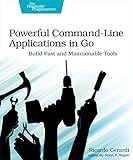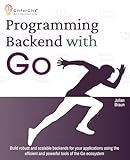Best HTML Rendering Tools in Golang to Buy in December 2025

Hands-On Software Architecture with Golang: Design and architect highly scalable and robust applications using Go



Powerful Command-Line Applications in Go: Build Fast and Maintainable Tools



Concurrency in Go: Tools and Techniques for Developers



Distributed Services with Go: Your Guide to Reliable, Scalable, and Maintainable Systems



GOLANG PROGRAMMING FOR BEGINNERS: A BEGINNER’S BLUEPRINT TO BUILDING APPS AND UNLOCKING CODING SUCCESS



Foundations of Debugging for Golang



Domain-Driven Design with Golang: Use Golang to create simple, maintainable systems to solve complex business problems



Programming Backend with Go: Build robust and scalable backends for your applications using the efficient and powerful tools of the Go ecosystem



GoLang Programming For Beginners: A Step-by-Step Guide To Learning Go For Modern Software Development


To render HTML in Golang, you can follow these steps:
- Import the necessary packages:
import ( "fmt" "net/http" "html/template" )
- Create a handler function to handle the HTTP request and response:
func handler(w http.ResponseWriter, r *http.Request) { // Render the HTML template tmpl, err := template.ParseFiles("template.html") if err != nil { fmt.Println("Error parsing template:", err) return }
data := struct {
Title string
Message string
}{
Title: "My Page",
Message: "Welcome to my page!",
}
err = tmpl.Execute(w, data)
if err != nil {
fmt.Println("Error executing template:", err)
return
}
}
- Define an HTML template file ("template.html") with placeholders for dynamic data:
- Set up a HTTP server and register the handler function:
func main() { http.HandleFunc("/", handler) http.ListenAndServe(":8080", nil) }
- Start the server and navigate to "http://localhost:8080" in your web browser to see the rendered HTML.
This is a basic example of rendering HTML in Golang using templates. You can customize the template and data as per your requirements. Remember to handle error conditions appropriately in a real application.
What is the purpose of the template.Must() function in Golang?
The purpose of the template.Must() function in Golang is to simplify error handling when parsing templates.
When parsing templates in Go, the template.Parse() function returns a template.Template and an error. The template.Must() function takes these returned values, checks if the error is nil, and if it is not nil, it panics with the error message.
In this way, template.Must() provides a convenient way to handle errors during template parsing. It allows you to write concise code without explicitly checking for errors, assuming that the parsing is successful. However, if there is an error during parsing, it will panic, which can simplify the error handling process.
How to handle errors during HTML rendering in Golang?
In Golang, error handling during HTML rendering can be done using the standard html/template package. Here are a few approaches you can follow to handle errors during HTML rendering:
- Parse errors: Use the template.ParseFiles() function to parse the HTML template files. It returns an error if there is any issue with the template syntax. Handle this error to log or display an appropriate message to the user.
template, err := template.ParseFiles("template.html") if err != nil { log.Fatal(err) }
- Execute errors: When rendering the template, use the template.Execute() or template.ExecuteTemplate() functions to apply data to the template. It also returns an error if there are any issues while executing the template. Again, handle this error to log or display an appropriate message.
err := template.Execute(w, data) // Assuming "w" is the response writer and "data" is the template data if err != nil { log.Println(err) http.Error(w, "Internal Server Error", http.StatusInternalServerError) return }
- Error handling in templates: Inside the template itself, you can use the {{if}} and {{else}} directives to handle potential errors. For example, if you want to handle an empty or nil value, use the {{if}} directive to check for the value and provide an alternative rendering if it's not present.
{{if .MyValue}} {{.MyValue}} {{else}} No value found {{end}}
By following these approaches, you can gracefully handle errors during the HTML rendering process in Golang.
How to pass data to HTML templates in Golang?
In Golang, you can pass data to HTML templates using the html/template package. Here's a step-by-step guide on how to pass data to HTML templates:
- First, import the html/template package:
import ( "html/template" "net/http" )
- Create a struct type to hold your data. For example, if you want to pass a person's name and age to the template, you can define a struct like this:
type Person struct { Name string Age int }
- Create an HTML template file with placeholders for the data. For example, you can create a file named template.html with the following content:
The placeholders {{.Name}} and {{.Age}} will be replaced with the actual data when rendering the template.
- Create a handler function to render the template and pass the data:
func MyHandler(w http.ResponseWriter, r *http.Request) { // Create an instance of the Person struct with your data person := Person{Name: "John Doe", Age: 30}
// Parse the HTML template file
tmpl, err := template.ParseFiles("template.html")
if err != nil {
http.Error(w, err.Error(), http.StatusInternalServerError)
return
}
// Render the template with the data
err = tmpl.Execute(w, person)
if err != nil {
http.Error(w, err.Error(), http.StatusInternalServerError)
return
}
}
- Finally, set up a server to handle requests and call the handler function:
func main() { http.HandleFunc("/", MyHandler) http.ListenAndServe(":8080", nil) }
Now, when you visit http://localhost:8080, the template.html file will be rendered with the data passed to it.
Note: Make sure that the template.html file is in the same directory as your Go code file, or you provide the correct path to it in ParseFiles() function.
How to render HTML tables in Golang using templates?
To render HTML tables in Golang using templates, you can follow these steps:
Step 1: Define the table structure First, define a data structure that represents the table and its data. This will typically be a struct with fields for each column in the table.
type TableData struct { Headers []string Rows [][]string }
Step 2: Create a template Create an HTML template that defines the structure and layout of the table. You can use the html/template package for this.
Step 3: Render the template In your Go code, parse the HTML template and execute it with the table data.
func main() { // Define table data data := TableData{ Headers: []string{"Name", "Age", "Country"}, Rows: [][]string{ {"John Doe", "30", "USA"}, {"Jane Smith", "25", "Canada"}, {"Bob Johnson", "40", "UK"}, }, }
// Parse template
tmpl, err := template.ParseFiles("table.html")
if err != nil {
log.Fatal(err)
}
// Render template with data
err = tmpl.Execute(os.Stdout, data)
if err != nil {
log.Fatal(err)
}
}
Ensure that the table.html file is in the same directory as your Go code.
Running this code will render the table HTML in the terminal. If you want to render it in a web server response, you can use the http package to serve the HTML.
How to render HTML emails in Golang using templates?
To render HTML emails in Golang using templates, you can follow these steps:
-
Install the html/template package, which provides functionality to parse and execute HTML templates.
-
Create an HTML email template file with the extension ".html". This file will contain the HTML structure and placeholders for the dynamic content. Example email template file named "email_template.html":
Welcome, {{.Name}}
We are glad to have you on board!
-
Create a Go file that will render the email template: package main import ( "fmt" "html/template" "net/smtp" ) type EmailData struct { Name string } func main() { // Define the data to be passed to the email template data := EmailData{Name: "John Doe"} // Parse the email template file t, err := template.ParseFiles("email_template.html") if err != nil { fmt.Println("Error parsing template:", err) return } // Create a buffer to hold the rendered HTML content htmlContent := new(bytes.Buffer) // Render the email template with the provided data err = t.Execute(htmlContent, data) if err != nil { fmt.Println("Error executing template:", err) return } // Convert the HTML content buffer to a string htmlString := htmlContent.String() // Send the email with the rendered HTML content sendEmail(htmlString) } func sendEmail(htmlContent string) { // Code to send the email with the rendered HTML content goes here } Note: Update the sendEmail function with the logic specific to your email sending mechanism (e.g., using the net/smtp package or a third-party library).
-
When you run this Go code, it will parse the template file, render it with the provided data, and produce a string representation of the HTML content. You can then use this rendered content to send the email.
Make sure to customize the code according to your email sending requirements, including the configuration for your email provider.
